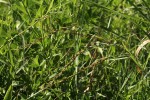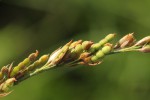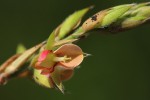| Home | > | List of families | > | Fabaceae subfamily Papilionoideae | > | Alysicarpus | > | glumaceus |
Alysicarpus glumaceus
glumaceus
Selected images: Click on each image to see a larger version and details of the record View all images (6)
Detailed records: Display species records QDS maps by: Google Maps Point records by Google Maps
Species details: Click on each item to see an explanation of that item (Note: opens a new window)
| Synonyms: |
Alysicarpus hochstetteri A. Rich. Alysicarpus violaceus (Forssk.) Schindl. Hedysarum glumaceum Vahl Hedysarum violaceum Forssk. |
| Common names: | |
| Frequency: | |
| Status: | Native |
| Description: |
Erect or procumbent annual herb, often somewhat woody at the base, 0.15–1.5 m tall. Stems pubescent mostly in narrow longitudinal lines. Leaves 1-foliolate oblong, oblong-lanceolate or linear-lanceolate, 0.65–12.5 cm long, finely velvety and with longer hairs on lower surface; petiole 2–7 mm long; stipules lanceolate, 4–16 mm long. Inflorescences terminal and leaf-opposed 3–30 cm long; pedicels mostly 2–5 mm long. Calyx pubescent; with lobes lanceolate or narrowly triangular, 4–6 mm long, not or only slightly overlapping at the base, pubescent and ciliate with white hairs or hairless. Standard salmon-coloured, red or mauve, obovate, 5–6 mm long; wings and keel often pale, but purple on the margins. Fruit 7–15 mm long, much constricted between the articles; articles 4–7, transversely elliptic, with strong close transverse ridges which join up here and there, up to 3 mm long and wide, shortly pubescent. |
| Type location: |
Yemen |
| Notes: | Two varieties within subsp. glumaceus have been described. Both varieties have been recorded from Mozambique. Most widespread is var. intermedius Verdc. This variety is recognised by somewhat broader calyx lobes, 5.5-7.5 mm long and up to 2.5 mm wide , which somewhat overlap at the base. The fruit is only slightly exserted from the calyx at best. Var. glumaceus was so far only recorded from the extreme South of the country. It is recognised by narrower calyx lobes, 4-6 mm long and 1 mm wide , which only scarcely overlap at the base or not at all. The fruit is well exserted from the calyx. I needs to be noted that the specimen in the images from Gorongosa National Park best matches var. glumaceus so this variety may be more widespread than previously assumed. |
| Derivation of specific name: | |
| Habitat: | In grassland, wooded grassland or woodland, often on black cotton soils in swampy grasslands or on floodplains and sometimes as a weed in maize fields or on dunes. |
| Altitude range: (metres) | 5 - 540 m |
| Flowering time: | |
| Worldwide distribution: | Widespread from Arabia, throughout Africa to KwaZulu-Natal, South Africa. |
| National distribution: | N,Z,MS,GI,M |
| Growth form(s): | |
| Endemic status: | |
| Red data list status: | |
| Insects associated with this species: | |
| Spot characters: | Display spot characters for this species |
| Images last updated: | Wednesday 8 November 2017 |
| Literature: |
Da Silva, M.C., Izidine, S. & Amude, A.B. (2004). A preliminary checklist of the vascular plants of Mozambique. Southern African Botanical Diversity Network Report No. 30 Sabonet, Pretoria Page 65. as Alysicarpus glumaceus subsp. rugosus? Mapaura, A. & Timberlake, J. (eds) (2004). A checklist of Zimbabwean vascular plants Southern African Botanical Diversity Network Report No. 33 Sabonet, Pretoria and Harare Page 46. Setshogo, M.P. (2005). Preliminary checklist of the plants of Botswana. Sabonet Report no. 37. Sabonet, Pretoria and Gaborone Page 61. Verdcourt, B. (2000). Papilionoideae Flora Zambesiaca 3(6) Pages 37 - 43. (Includes a picture). |
Other sources of information about Alysicarpus glumaceus subsp. glumaceus:
Our websites:
Flora of Botswana: Alysicarpus glumaceus subsp. glumaceusFlora of Malawi: Alysicarpus glumaceus subsp. glumaceus
Flora of Zimbabwe: Alysicarpus glumaceus subsp. glumaceus
External websites:
African Plants: A Photo Guide (Senckenberg): Alysicarpus glumaceusAfrican Plant Database: Alysicarpus glumaceus
BHL (Biodiversity Heritage Library): Alysicarpus glumaceus
EOL (Encyclopedia of Life): Alysicarpus glumaceus
GBIF (Global Biodiversity Information Facility): Alysicarpus glumaceus
Google: Web - Images - Scholar
iNaturalist: Alysicarpus glumaceus
IPNI (International Plant Names Index): Alysicarpus glumaceus
JSTOR Plant Science: Alysicarpus glumaceus
Mansfeld World Database of Agricultural and Horticultural Crops: Alysicarpus glumaceus
Plants of the World Online: Alysicarpus glumaceus
Tropicos: Alysicarpus glumaceus
Wikipedia: Alysicarpus glumaceus
| Home | > | List of families | > | Fabaceae subfamily Papilionoideae | > | Alysicarpus | > | glumaceus |





